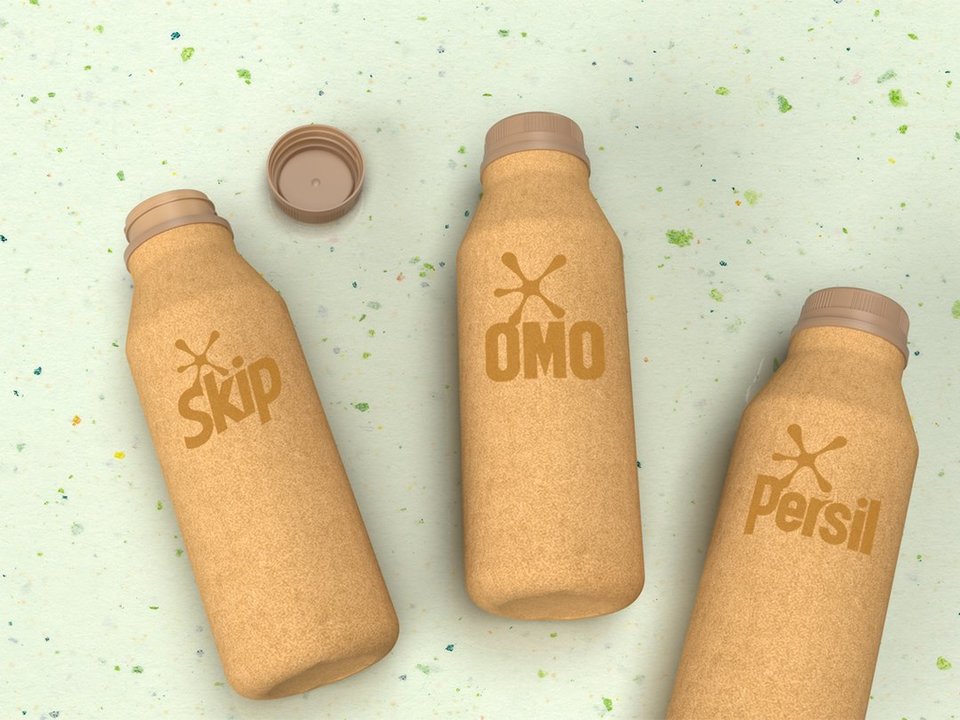paper
Pulp fiction becomes pulp fact: Unilever’s paper bottle
In June, Unilever announced the development of a paper-based laundry detergent bottle to debut in Brazil in 2022, with ambitions to roll out to other countries soon after. Jessica Paige speaks to Colin Kerr, R&D packaging director for Unilever, to find out more about the product.

The new plastic-free laundry detergent bottle from Unilever was made in partnership with the Pulpex consortium, a packaging technology company aiming to deliver sustainability through renewable packaging.
The product has been developed for laundry brand Persil – also known as OMO, Skip, and Breeze – and is debuting in Brazil, as the country is a key market for the brand.
R&D packaging director for Unilever Colin Kerr says that the product is being created to tackle plastic waste.
“We’ve been working hard to keep our plastic packaging out of the environment and in the economy where it belongs,” says Kerr.
“To tackle the root causes of plastic waste, we need to think differently about the materials we use, how we design our packaging, new models such as reuse and refill, and how we can help collect, process, and repeatedly use materials.”
Many brands produce laundry detergent in bottles made of plastic, with the most common material for the packaging being high-density polyethylene plastic (HDPE).
While HDPE is classified as a number two material, meaning it can be recycled in modern recycling centres, the production of plastic of any type causes damage to the environment.
The life cycle of plastic detergent bottles
The manufacturing process of plastic is, in itself, damaging to the eco-system. Producing plastic requires crude oil, a non-renewable fossil fuel that needs to be extracted from the land or ocean floor with drilling machines.
The extraction process releases toxic gases and greenhouse gases, and in the case of offshore oil rigs, upsets ocean and marine life.
Once the oil is extracted, it is sent for distillation in an oil refinery, which requires a high volume of transportation. The amount of transportation required damages the environment further as ships and other transportation methods burn fossil fuels and emit greenhouse gases.
To create the HDPE, a process called cracking is used that creates ethylene gas in order to make the material mouldable, followed by further shipping as the new detergent bottle is sent across bottle manufacturing facilities, packaging factories, and grocery stores.
At the end of the bottle's life, the product can be recycled. However, although HDPE is fully recyclable and easy to do so at modern recycling facilities, a large portion of plastic laundry detergent bottles are not recycled correctly
Only 28% of HDPE jugs are being recycled, according to UK-based plastic recycling company Plastic Expert.
Paper applications combat plastic waste
One way companies can combat plastic waste and environmental damage caused by producing plastic laundry detergent bottles is by using alternative materials.
Kerr says: “We are exploring alternatives to plastic, and Pulpex’s technology provides a promising solution to create fully recyclable, paper-based bottles without additional plastic layers that also work with liquid products.”
The new bottle by Unilever will be made from sustainably sourced pulp and is designed to be recycled in the paper waste stream.
The bottles will be coated inside with a proprietary coating designed to repel water, meaning that the product can hold liquid products like laundry detergent, as well as shampoos and conditioners.
Though paper packaging tackles plastic waste, there is debate in the packaging industry on its eco-friendly properties. This is because paper takes four times the energy needed to produce than plastic. It is also heavier to transport than plastic.
However, at the end of its life, paper is recycled more often than plastic and is easier to compost and biodegrade. It avoids the problem too that plastic has of entering marine streams, where plastic doesn’t biodegrade and subsequently pollutes the ocean and hurts marine life.

The paper bottle was developed in partnership with the Pulpex Consortium. Credit: Unilever
When asked why Unilever decided on paper over another materials, such as aluminium or bamboo, Kerr says: “We are exploring a range of alternative materials to plastic, including aluminium, glass, paper and board where possible, and removing plastic completely where it is not necessary.
“For example, Seventh Generation has launched a zero-plastic range, while PG Tips is removing the plastic film from boxes in 2021, having already launched fully biodegradable teabags.
“In Chile, we have partnered with Algramo to deliver a refill model directly to consumers at home, and recently in the UK we announced plans to scale up our biggest refill trial to date in Europe, in partnership with retailer Asda and sustainability experts Beauty Kitchen.”
The future on paper
Unilever has plans to use the same technology used in the paper laundry detergent bottle in other lines in the future, such as for hair care products and refill formats.
As for the company’s sustainability goals, the company has set itself multiple targets to be reached by 2025, including halving its use of virgin plastic and to help collect and process more plastic packaging than it sells.
It is also aiming for 100% of its plastic packaging to be fully reusable, recyclable, or compostable, and to increase the use of post-consumer recycled plastic material in its packaging to 25%.
“We’re transforming our approach to plastic packaging through a ‘Less plastic, Better plastic, No plastic’ innovation framework,” says Kerr.
“This year, we have developed our strategy further by investing in a dedicated Science & Technology packaging team, responsible for accelerating innovations that reduce the use of plastic.
“The move to a circular economy will also be dependent on what happens downstream after people use our products.
"We’re working with governments to improve waste infrastructure – such as collection, processing, and recycling projects – and partnering with hundreds of organisations to bring about change.”